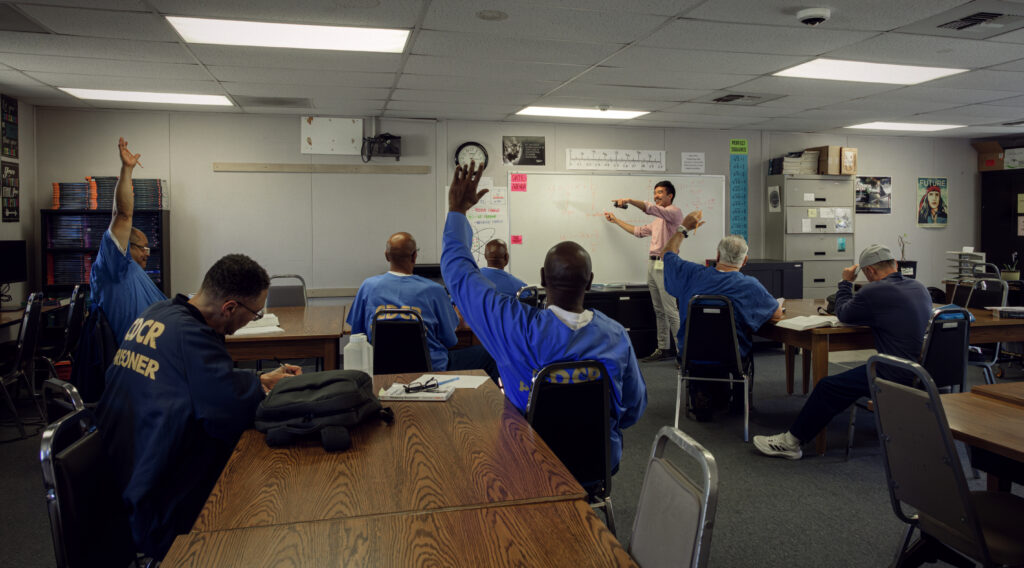
Students in a Mount Tamalpais College class at San Quentin Prison.
Credit: R.J. Lozada/Mount Tamalpais College
Graduates from one of the most unusual community colleges in the country will soon receive guaranteed admission if they choose to transfer to the California State University system.
But first, they’d need to be released from prison.
The nation’s largest public university system is developing a new college transfer program with Mount Tamalpais College, which is located within San Quentin State Prison. The private two-year college is the first accredited institution created within a state prison.
“This transfer program goes right to the heart of our values as an institution and a system,” said Laura Massa, CSU’s interim associate vice chancellor for academy and faculty programs. “People in California, and, well, everywhere, should have access to a high-quality education. There is plenty of data out there on this, that having an educational opportunity is so important to folks who have been incarcerated.”
And that education is one of the main reasons why formerly incarcerated people are successful and become contributing members of their communities, she said.
College-in-prison programs have generally been well received, especially politically, because research shows bachelor’s and associate degree programs in prison reduce recidivism rates and help formerly incarcerated people find jobs once they are released.
Although CSU and Mount Tamalpais are still working out the details, once they are released, students who complete their associate degree at Mount Tamalpais will receive priority admission for a bachelor’s degree program at any of the 23 CSU campuses they apply to. The college currently offers an Associate of Arts degree in liberal arts, and the guaranteed transfer degree with CSU may resemble the Associate Degree for Transfer the university system now accepts from the state’s community college system. There are 26 Mount Tamalpais graduates currently incarcerated in San Quentin.
The program is part of a larger trend unfolding across California’s state prison system. Nearly all the state’s 34 prisons offer associate degree programs through the California Community College system. More recently, the University of California and CSU systems have started offering bachelor’s degree programs in some prisons.
Corey McNeil, a Mount Tamalpais graduate who was formerly incarcerated in San Quentin, said the guaranteed admission agreement is another sign that, despite being in prison, the students are completing quality work. McNeil was released from San Quentin in 2021 and is currently a student at San Francisco State University.
“It’s another level of acceptance,” said McNeil, the alumni affairs associate for the college. “There is a sense among the students that people think the education provided inside the prison is subpar or not the same as in traditional college. So this is huge. It shows that the education you receive in prison, that the CSUs are acknowledging that and saying we’ll accept that.”
Massa said the agreement with the college could only happen because Mount Tamalpais achieved accreditation. The nearly 30-year-old college exclusively for incarcerated people in California’s oldest prison became the first in the country to become fully accredited in 2022. Since then the college has graduated about 25 students, said Amy Jamogochian, chief academic officer at the college.
San Quentin houses about 3,000 people and has 536 students. Some students take a semester off, so enrollment is currently about 300.
“The fact that CSU is so eager to do this is really heartening,” Jamogochian said. “We want to serve formerly incarcerated people, and we want to make sure they’re doing OK.”
The school-to-prison pipeline and the “learning-disability-to-prison pipeline” exist in California and unfortunately can’t be solved at the college level, Jamogochian said. But Mount Tamalpais and other colleges entering prisons are trying to address that reality and offer strong academics and student support, she said.
Massa said the college and the university system will continue working on the details of the guaranteed admission program so that graduates can be admitted as soon as fall 2024.


